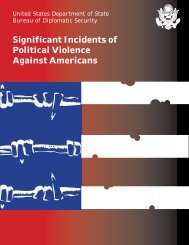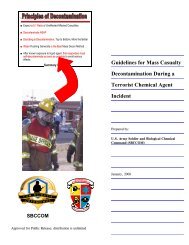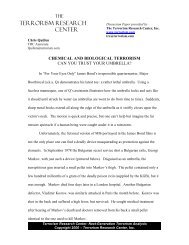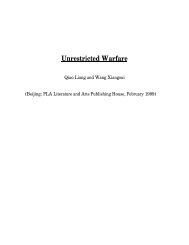Combating Proliferation of Weapons of Mass Destruction
Combating Proliferation of Weapons of Mass Destruction
Combating Proliferation of Weapons of Mass Destruction
Create successful ePaper yourself
Turn your PDF publications into a flip-book with our unique Google optimized e-Paper software.
Because OEE has a larger national field presence than EA, special agents conductoutreach activities to educate the exporting community about its responsibility to complywith U.S. export laws. Special agents not only participate in the export control seminarsconducted by EA but also visit exporters and freight forwarders on a regular basis. Eachyear, OEE conducts Business Executive Enforcement Team meetings in several locationsaround the country. This visibility within the exporting community provides exporters witha face and a name to contact when they have concerns and OEE special agents receivea large number <strong>of</strong> tips and leads regarding suspicious transactions from industry sources.OEE special agents conducted over 1,200 outreach contacts in fiscal year 1998.Office <strong>of</strong> Enforcement Analysis. The Office <strong>of</strong> Enforcement Analysis (OEA) is staffedwith analysts who conduct data analysis from a variety <strong>of</strong> sources to stem the proliferation<strong>of</strong> goods and technology which would contribute to WMD projects. Two major initiatives arethe Shipper’s Export Declaration (SED) Review program and the Visa Review program.The Foreign Trade Statistics Regulations (15 CFR Part 30) and the Export AdministrationRegulations require the filing <strong>of</strong> a Shipper’s Export Declaration for almost all exports fromthe U.S. These declarations identify the exporter; the consignee; the Schedule Bidentifying code, which generally describes the commodity being exported; the licensedesignation or license exception; and the country <strong>of</strong> destination. Currently SEDs arereceived by the U.S. Government primarily on a post shipment basis and largely in paperform. The current system is very limited as an interdiction tool and would benefit hugelyfrom mandatory participation in an automated export clearance process. (See below.)While EE’s special agents conduct periodic reviews <strong>of</strong> SEDs at freight forwarders and atthe ports, OEA conducts SED reviews on a post-shipment basis. OEA receives acomputerized index <strong>of</strong> select SED information from the Census Bureau which collects andretains the information from the SEDs. The index allows a search based on targeted fields.With the search results, analysts can examine transactions for further review, focusing oncertain license exception shipments, shipments <strong>of</strong> commodities <strong>of</strong> proliferation concern,and shipments bound for certain destinations. When SEDs indicate a possible violation,OEA analysts refer the matter to special agents in the field. In fiscal year 1998, OEAanalysts referred 363 SED review cases to the field.Enforcement initiated the Visa Review Program in 1990, which examines applications forvisas from an export control and technology transfer perspective. In fiscal year 1998,Enforcement restructured the program developing new criteria and thresholds againstwhich incoming visa applications are evaluated. The focus is narrower and concentrateson specific technologies targeted for use in WMD projects. When a specific visaapplication raises concerns, OEA analysts can request special agents in the field conductadditional investigation into the proposed visit. Based on OEA and OEE information andrecommendations, the State Department has in the past declined to issue visas due to therisk <strong>of</strong> transfer <strong>of</strong> sensitive technology and in a few cases, analysts have uncovered visafraud which was referred to State’s Fraud Unit for further investigation.86







